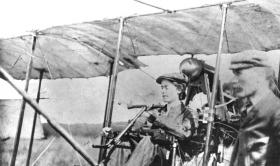From the files of the DIB…
Published in 18th–19th - Century History, 20th-century / Contemporary History, Features, Issue 1 (Jan/Feb 2010), Volume 18
Lilian Bland c. 1910 in her home-made biplane, ‘Mayfly’. (Ulster Aviation Society)
BLAND, Lilian Emily (1878–1971), pioneer aviatrix, was born on 28 September 1878 in Kent, youngest child among one son and two daughters of John Humphrey Bland (1828–1919) of Fernagh, Whiteabbey, Co. Antrim, and Emily Charlotte Bland (née Madden) of Norfolk, granddaughter of Robert Wintringham Bland (1794–1880), dean of Belfast. She was brought up by her aunt, Sarah Maria Wintringham Smythe (d. 1918), widow of General W. J. Smythe.
A spirited woman, she was an excellent shot, a keen horsewoman and one of the first female journalists; specialising in sports events, she wrote well, had a lively sense of humour and was widely admired for her photographic skills. She also contributed articles on bird flight, which stimulated her interest in flight mechanics. Inspired by the pioneering cross-Channel flight (25 July 1909) by Louis Blériot (1872–1936), and receiving a postcard with the dimensions of his monoplane, she decided to build a scale model. After attending the first British aviation meeting in Blackpool (October 1909), she returned to the family estate, Tobercooran House, Carnmoney, Co. Antrim, full of ideas to design, build and fly the first powered machine in Ireland. She constructed a biplane glider from bamboo, ash and elm, wittily christened ‘Mayfly’ (her own preferred spelling). She claimed that it flew at 30mph: ‘My only difficulty is to prevent her flying when I do not want her to’.
She purchased a 20hp two-stroke engine, but delay in receiving the fuel tank led her to devise a temporary fuel system consisting of a whiskey bottle and her aunt’s ear-trumpet. In September 1910 she announced ‘I have flown . . . it was dead calm, so there was no wind to help her . . . I did not know I was off the ground!’ She rose 30 feet into the air. She wrote several letters (1909–11) to Flight describing her experiences and discussing in detail various design features, and in a comprehensive article with photographs and diagrams, ‘The “Mayfly”—the first Irish biplane. And how she was built’ (Flight, no. 103, 17 December 1910, 1025–7), she described flying as the finest sport in the world.
Aspiring to start an aircraft company, she advertised her improved ‘May-fly’ (the spelling used in advertisements), standard or racing, from £250 without engine, in Flight, but when her anxious father promised her a Model T Ford motor car she agreed to dispose of her plane. After purchasing her car in Dublin, she persuaded the delivery driver to allow her to take the wheel and quickly mastered the skill of driving. She then became Ford’s Belfast agent for selling cars (April 1911).
In October 1911 she married her cousin, Charles Loftus Bland of Vancouver Island, and emigrated to Canada; they had one daughter, Patrick Lilian (1913–29), who died from tetanus. In 1935 Bland returned to England; at some point she became a landscape gardener. She retired (1955) to Cornwall, where she painted, tended her garden and enjoyed gambling. She died on 11 May 1971. HI
Helen Andrews was formerly an editorial assistant with the Royal Irish Academy’s Dictionary of Irish Biography.
















